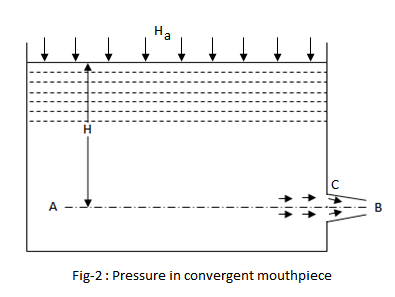Convergent Mouthpiece
Discharge and Pressure in a Convergent Mouthpiece
Discharge Through A Convergent Mouthpiece
Generally a jet of liquid gets contracted at the entrance of a mouthpiece. There is always some loss of head due to this contraction of the jet. To counteract the loss of head, due to contraction of the jet up to vena contract, the mouthpiece is given the same slope as that of the jet of liquid as shown in fig-1.
= Height of the liquid above the mouthpiece
= Area of the orifice at point B, and
= Velocity of the jet
Example:
[metric]
Example - Discharge through a Convergent Mouthpiece
Problem
A convergent mouthpiece is discharging water under a constant head of 5m. Find the discharge, if diameter of the mouthpiece is 75 mm.
Workings
Given,
^2&space;=&space;\frac{\pi}{4}&space;\times&space;(0.075)^2&space;=&space;4.418\times&space;10^{-3}\;m^2) and discharge through the mouthpiece,
and discharge through the mouthpiece,

\times&space;\sqrt&space;{2\times&space;9.81\times&space;5}&space;m^3/s)

= 5m
= 75mm = 0.075m
Solution
Discharge through the mouthpiece = 43.8 liters/s
Pressure In A Convergent Mouthpiece
Consider a vessel, open to atmosphere at its top, having an orifice fitted with a convergent mouthpiece as shown in fig-2. We know that the slope of the mouthpiece is the same as that of the jet up to vena contracta.
= Atmospheric pressure head
= Height of liquid above the the mouthpiece
= Absolute pressure head at vena contracta, and
= Velocity of the jet
 Login
Login

